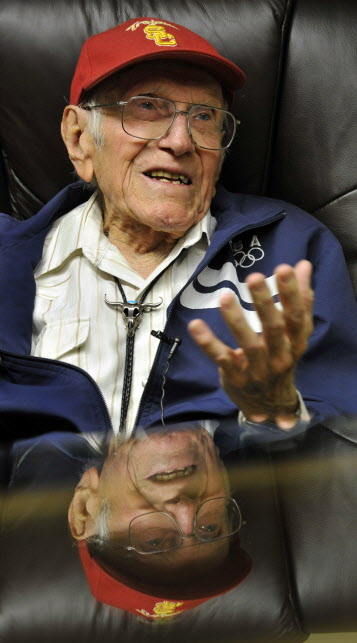 Carlton Hudson, who turned 100 on Jan. 26, shows a model of a B-24 in 2012. Hudson was shot down over Germany in 1944. (Photo by Travis Spradling, used by permission of The Advocate, Baton Rouge, Louisiana)
Carlton Hudson, who turned 100 on Jan. 26, shows a model of a B-24 in 2012. Hudson was shot down over Germany in 1944. (Photo by Travis Spradling, used by permission of The Advocate, Baton Rouge, Louisiana)
By George Morris
Carlton Hudson believes in guardian angels. If he’s right, his worked overtime during World War II. And it’s still going strong.
Hudson, a longtime Central resident who turned 100 on Jan. 26, didn’t get through the war unscathed. Shot down over Germany, he was wounded by rifle fire and spent seven months as a prisoner of war.
But, brushes with death were part of Hudson’s entire war experience, even before he faced the enemy.
Continue reading “Guardian angels working overtime for Carlton Hudson”
 Don Menard shows a letter and gifts he received in 2004 from Vasily Bezugly, a Soviet soldier who helped liberate Menard at Stalag Luft 1 near the end of World War II in Europe. (Photo used by permission of The Advocate, Baton Rouge, Louisiana.)
Don Menard shows a letter and gifts he received in 2004 from Vasily Bezugly, a Soviet soldier who helped liberate Menard at Stalag Luft 1 near the end of World War II in Europe. (Photo used by permission of The Advocate, Baton Rouge, Louisiana.) Nolan Ruiz, left, and Mervin Medine knew each other in elementary school, and it was Medine’s unit that liberated Ruiz from captivity near the end of World War II. (Photo by Travis Spradling, used by permission of The Advocate, Baton Rouge, Louisiana)
Nolan Ruiz, left, and Mervin Medine knew each other in elementary school, and it was Medine’s unit that liberated Ruiz from captivity near the end of World War II. (Photo by Travis Spradling, used by permission of The Advocate, Baton Rouge, Louisiana)
 Tom Grace was part of an Army Ranger unit that liberated more than 500 prisoners from Cabanatuan, Philippines. (Photo by Patrick Dennis, used by permission of The Advocate, Baton Rouge, Louisiana)
Tom Grace was part of an Army Ranger unit that liberated more than 500 prisoners from Cabanatuan, Philippines. (Photo by Patrick Dennis, used by permission of The Advocate, Baton Rouge, Louisiana) Conrad Meijer was a Dutch civilian teenager who spent much of World War II as a prisoner of the Japanese. (Photo by Patrick Dennis, used by permission of The Advocate, Baton Rouge, Louisiana.)
Conrad Meijer was a Dutch civilian teenager who spent much of World War II as a prisoner of the Japanese. (Photo by Patrick Dennis, used by permission of The Advocate, Baton Rouge, Louisiana.) P-51 pilot Osce R. Jones poses beside his aircraft. (Photo provided by Carol Ann Jones Lizana)
P-51 pilot Osce R. Jones poses beside his aircraft. (Photo provided by Carol Ann Jones Lizana) This flag, on display in the National Museum of the Pacific War in Fredericksburg, Texas, was made by prisoners of war held by the Japanese and is similar to one made by POWs held in Davao, Philippines, and Toyama, Japan, during World War II. (Photo by George Morris)
This flag, on display in the National Museum of the Pacific War in Fredericksburg, Texas, was made by prisoners of war held by the Japanese and is similar to one made by POWs held in Davao, Philippines, and Toyama, Japan, during World War II. (Photo by George Morris)
 Bilibid Prison, a POW camp during World War II
Bilibid Prison, a POW camp during World War II